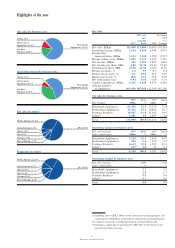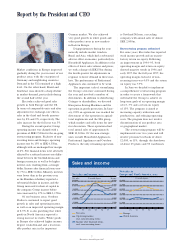Electrolux 1997 Annual Report Download - page 12
Download and view the complete annual report
Please find page 12 of the 1997 Electrolux annual report below. You can navigate through the pages in the report by either clicking on the pages listed below, or by using the keyword search tool below to find specific information within the annual report.
8
Electrolux Annual Report 1997
and through comprehensive changes in
the Group’s marketing and sales organi-
zations. Prior to the start of the restruc-
turing program, the Group had about
150 plants and approximately 300
warehouses.
Although the program refers
mainly to Europe, in particular to white
goods, floor-care products and opera-
tions in Professional Appliances, most
of the Group’s units will be affected in
some way. In terms of plant shutdowns,
Professional Appliances accounts for
the greatest number as this business
area also shows the most fragmented
structure, with many small units.
However, Household Appliances will
account for the largest share of restruc-
turing costs and personnel cutbacks.
As I mentioned previously, the cost
of the program is estimated at about
SEK 2,500m, which was charged in its
entirety against income in the second
quarter. About 80% of the cost refers to
personnel cutbacks and the rest to relo-
cation costs and write-downs on assets.
To date, our judgement is that the pro-
vision should be sufficient.
By year-end, about 3,800 employees
had left the Group as a result of the
program, and about SEK 700m of the
provision had been utilized. Negotia-
tions on shutdowns had been initiated
or completed at 16 plants, which will be
closed at various dates during 1998, and
in some cases during 1999. The larger
units include two plants in the UK, for
refrigerators and floor-care products,
one in Finland for refrigerators, one in
Hungary for freezers and one in Sweden
for food-service equipment. Compre-
hensive changes are also being made in
white goods in Germany, including
rationalization of production of washers
and spin-driers. A total of 17 ware-
houses had been closed by year-end,
and shutdowns of another 16 had
been authorized.
The program is on track to date. We
expect that its positive effects will start
to become apparent during the second
half of 1998. Naturally, the full effect
will not be achieved until after 2000,
i.e. following the final implementation
of the program in 1999.
Organizational changes
In order to create clearly defined areas
of responsibility and a better overview
of on-going operations, immediately
after I joined the Group I introduced
a new organization with six operating
sectors instead of fifteen product lines
that reported directly. The number of
staff functions was also reduced from
twelve to five.
All sector and staff heads are
included in the Group’s executive man-
agement group, which meets once a
month. In addition I have quarterly
reviews of current operations and strate-
gies in each sector. Since June we have
had two meetings with the Group’s one
hundred senior managers.
The aim of the new organization
is to contribute to a better focusing of
internal resources and processes.
Development of competence
With regard to the professional devel-
opment of the Group’s managers, we
need to encourage greater mobility
between operations and countries. We
also have to achieve greater diversity in
terms of age and nationality, with a
larger proportion of women in leading
positions.
A comprehensive program for
managerial development is now being
prepared as a complement to the leader-
ship training that is already offered
by the Electrolux University. During
the year a number of courses were
given in such areas as leadership, project
management, strategic development
and quality assurance, and we also offer
an MBA program in cooperation with
several other multinational corporations.
Report by the President and CEO
Restructuring
program
Severance
pay 80%
Removal
costs and
write-downs
on assets
20%
Total cost SEK 2,500 m,
booked in second quarter of 1997
Goal is to achieve
the Group’s long-term
financial goals:
Operating margin 6.5–7%
Return on equity 15%
Personnel reduction
of 12,000, i.e. 11%.
Shutdown of about 25 of
Group’s150 plants, and about
50 of 300 warehouses.
Comprehensive changes
in marketing and sales
organizations.
Most of program refers
to Household Appliances
and Professional Appliances
in Europe.
Timetable: About 2 years from
mid-1997.
As of Dec. 31, 1997:
Personnel cutbacks . . . . . . . . . . 3,800
Negotiations started
or completed at . . . . . . . . . . 16 plants
W arehouses:
Shutdown . . . . . . . . . . . . . . . . . . . . . . . . . . . . . . 17
N otice of shutdown . . . . . . . . . . . . . . . . . 16
























